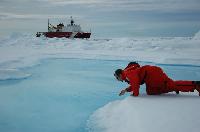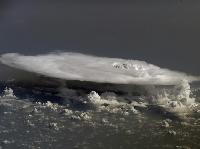Amazing Science Images You Must See
Amazing Science Images You Must See
71. Beyond Blue
A scientist explores the otherworldly Arctic in this 2005 photograph taken on an expedition to the oceans deep Canada Basin. The U.S. Coast Guard CutterHEALY stands in the background. The ship accommodates up to 50 scientists at a time and can cut through 4.5 feet (1.4 meters) of ice, opening up avenues for ocean exploration
72. Auroras Over America
Undulating high over Quebec and Ontario, the northern lights outshine city lights on Oct. 8, 2012. The strong aurora borealis resulted from a sun stormthree days earlier that sent solar particles on a collision course with Earths atmosphere. The interaction excites oxygen and nitrogen molecules 60 to 250 miles (100 to 400 kilometers) up, releasing photons, or light particles.
73. Psychedelic Sky
A stunning display of the northern lights brightens the sky in Whitehorse, Yukon, Canada on Oct. 1, 2012. This light show is the result of a coronal mass ejection, or a burst of solar particles and wind, three days before. When these solar particles interact with Earths upper atmosphere, they cause colorful, shimmering aurora like this green and purple specimen.
74. Awesome Weather Phenomenon
Unidentified flying object or weather event? Its the latter, of course this flat as a pancake cloud over Africa is whats called a cumulonimbuscloud, which means column rain in Latin. These clouds can form on their own or along cold fronts, bringing with them heavy rain, wind, lightning and even tornadoes.
75. Jewel of the Caribbean
Jewel like shallow waters hug the shores of Cuba in this image taken from the Envisat satellite in 2011. In order to get a cloudless view of the Caribbeanisland, researchers stitched together three snapshots. The Florida Keys are visible as a bright band northwest of Cuba, while the southeast tip of the island is darkened by the Sierra Maestra mountain range.
76. On Top of the World
Arctic sea ice caps the North Pole in this Aqua satellite image captured Sept. 3, 2010. Ice like this is in short supply lately, having just reached
77. The Tiny Face of a Killer
The visage of a tiny velvet ant peers up in this scanning electron microscope image magnified 23 times. This tiny creature, genusDasymutillais not actuallyan ant at all, but a wasp. She (this is a female) boasts a nasty sting, especially if youre another wasp or bee. In order to reproduce, velvet ants lay their eggs inside the larvae of wasps and bees. When the eggs hatch, they feed on the still living but paralyzed larvae that house them.
78. What in the World
Any guesses as to what this unusual tendril might be? Squid arm? Elephant trunk? Scroll down for the answer
79. The Perfect View
The story behind this sparkly blue glacial lagoon called the Jokulsarlon in Iceland is one of ice and climate. When the first settlers arrived in Iceland, the edge of an outlet glacier called Breidamerkurjokull and part of the great Vatnajokull glacier, was located about 12 miles (20 kilometers) farther north than it is today, according to J
80. The Pink Lady
Antarctic krill (Euphausia superba) plays a key role in the food webs of the South Ocean. In fact, throughout their evolutionary history, these tiny crustaceans have developed many biological rhythms that are closely connected to large seasonal changes in their environment.
But how will marine organisms like the krill react to environmental changes at the poles, such as receding sea ice and ocean warming, given that their vital processes, such as reproduction cycles and seasonable food availability, have been synchronized with the environment over millions of years? To answer this question, researchers in the virtual Helmholtz Institute PolarTime are taking a very close look at Antarctic krill, which serves as a model organism for a polar plankton species that has adapted to the extreme conditions. The Helmholtz institute is part of the Alfred Wegener Institute for Polar and Marine Research.














